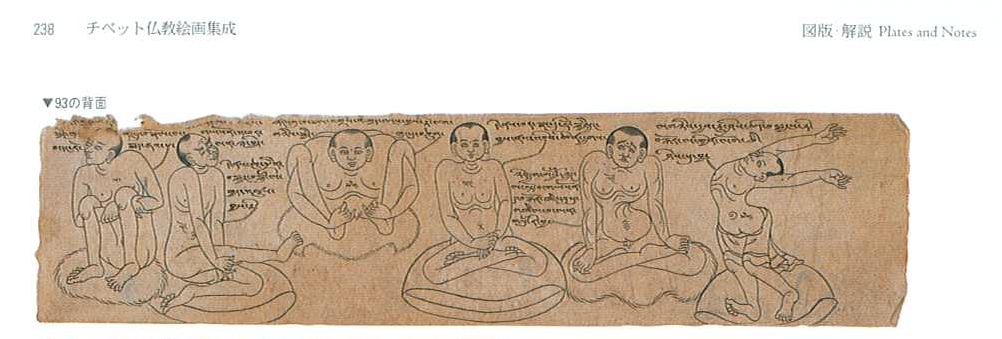大塚 伸夫 『インド初期密教成立過程の研究』 春秋社 (2013/1/31) 23,100円
Ōtsuka, Nobuo. Indo shoki mikkyō seiritsu katei no kenkyū (*Studies on the Formation Process of Early Indian Tantric Buddhism). Tokyo: Shunjūsha, January 31, 2013. 1100 pp. ISBN-13: 978-4393113110 [official site unofficial summary at Taishō U.]
Tanaka, Samājasādhanavyavastholī 4 (2012)
Pandey’s Siddham Script in Unicode proposal (2012/8)
Anshuman Pandey. ‘Proposal to Encode the Siddham Script in ISO/IEC 10646’.
ISO/IEC JTC1/SC2/WG2 N4294 L2/12-234R. PDF. 2012/08/01.
Mr. Pandey’s proposal – now no longer preliminary – promises to fill yet another gaping hole in the standard encoding of important Indic scripts. Now would be an appropriate time to comment, if you haven’t already commented.
(I would hope, at minimum, for the addition of a full set of ten digits in the final proposal. Often such basics fall through the gaps because the corpus of readily available primary material is so limited. Here‘s a nice “7-8th century” bilingual manuscript with a varṇamālā (no digits, though) which is both in good condition and readable online, thanks to the care of its Japanese custodians. Incidentally, this clearly confirms that two of the “Punctuation and ornaments” in Pandey’s Fig. 33 are ornamental final anusvāra [अं字].)
Comments should be emailed to Anshuman Pandey, whose address is given in the N4294 proposal (link above) and at the bottom of his personal website (link).

Yoshizaki, ‘The Kathmandu Valley as a Water Pot’ (2012)
 Long-time readers might remember this – now in print:
Long-time readers might remember this – now in print:
Yoshizaki, Kazumi (吉崎一美). The Kathmandu Valley as a Water Pot: Abstracts of research papers on Newar Buddhism in Nepal. Kathmandu: Vajra Books, 2012. 172 pp. ISBN: 9937506743. EAN: 9789937506748. USD$12.95. [official site]
[See Yoshizaki (1991), (1994a), (1994b), (1995), (1996a), (1996b), (1996c), (1997a), (1997b), (1997c), (1998a), (1998b), (1998c), (1998d), (1999), (2001), (2002a), (2002b), (2003a), (2003b), (2005a), (2005b), (2005c), (2007a) and several others.]
Emerging Unicode codeblocks
Recent discussion on the proposed Newar Unicode codeblock has been met with silence (signifying disinterest, ignorance, or unqualified approval – or all three, one must assume). Those who did more than glance at the discussion would have been aware that that several areas of the Unicode codespace are expanding rapidly, many of which are going to infringe upon a far wider chunk of Asianists’ and philologists’ territories. In an age of character-constrained discourse, when just a few letters can reveal something important about you – OMG!* – and a picture tells the thousand words you don’t have the time to text, demand for emoticons, emoji and pictographs soars.

The Symbola font [download] has reasonably good coverage of the newer codeblocks. Other fonts by the designer, George Doulos, show how much work (non-Indological) classicists are putting into the codification of the premodern repertoire.

Other fonts which cover recent additions to the standard, like Quivira, are easy to find online.
Continue reading “Emerging Unicode codeblocks”
Tanaka, ‘Art of Thangka 6’ (2012)
田中公明 『チベット仏敎絵画集成 : タンカの芸術 ハンビッツ文化財団蔵』 第6卷 臨川書店; ハンビッツ文化財団 15,750円
Tanaka, Kimiaki (ed.), Rolf W. Giebel (tr.) Art of Thangka: From the Hahn Kwang-ho Collection. Volume 6. Kyoto/Seoul: Rinsen Book Co. & The Hahn Cultural Foundation, 2012. 266 pp. ISBN-13: 978-4653041245 [amazon.jp / rakuten.co.jp]

Karashima et al, ‘Abhisamācārikā Dharmāḥ’ (2012) [Or: Inappropriate Monastic Wedding Speeches]
What the śrāvakas aren’t supposed to sing to the bride on the happy day:
nagnā nadī anodikā nagnaṃ rāṣṭram arājakam |
istrī 'pi vidhavā nagnā sacesyā daśa bhrātaraḥ || [sic]
This and other abhivinaya jocularity to be found in:
Seishi KARASHIMA unter Mitwirkung von Oskar von Hinüber. Die Abhisamācārikā Dharmāḥ Verhaltensregeln für buddhistische Mönche der Mahāsāṃghika-Lokottaravādins
herausgegeben, mit der chinesischen Parallelversion verglichen, übersetzt und kommentiert. Bibliotheca Philologica et Philosophica Buddhica Volume XIII.1, 2, 3 (Grammatik und Glossar). Tokyo: International Research Institute for Advanced Buddhology, Soka University, 2012. ISBN 978-4-904234-05-1 [PDF flyer fixed]
Hase, ‘Orissa: A Journey into Esoteric Buddhism’ (2012)
長谷 法寿 (編著) 河辺 利晴 (撮影) 『インド・オリッサ秘密佛教像巡礼』 柳原出版 12,000円+税 A4判変型
Hase, Hōju (ed.), Kawabe, Toshiharu (photography). Indo orissa: himitsu bukkyōzō junrei (Orissa, India: a Journey into Esoteric Buddhism and Its Iconography). Tokyo: Yanagihara Shuppan, April 2012 [official]. 286 pp. ISBN-13: 978-4840950244.
Giebel, ‘The 108 Names of Mañjuśrī’ (2011)
Nice to see some respect for Mañjuśrī in a journal on Indian Logic:
Rolf W. Giebel. ‘The One Hundred and Eight Names of Mañjuśrī: The Sanskrit Version of the Mañjuśrīkumārabhūta-aṣṭottaraśatakanāma Based on Sino-Japanese Sources’. Indian Logic 3 [インド論理学研究 第Ⅲ号], 2011 [平成23 年11 月30 日], pp.303–345.
Continue reading “Giebel, ‘The 108 Names of Mañjuśrī’ (2011)”
Tanaka, ‘Nāgabodhi’s *Samājasādhanavyavasthālī II’ (2011)
田中 公明 「『秘密集会』の身体曼荼羅論 : Nāgabodhiの安立次第論』第2章サンスクリット写本ローマ字化テキスト」 『東洋文化研究所紀要』 第160冊 2011.12
Tanaka, Kimiaki. ‘Nāgabodhi’s *Samājasādhanavyavasthālī: The Tibetan Translation and Sanskrit Text of Chapter II’ [in Japanese]. Tōyō Bunka Kenkyūjo kiyō 160, 2011, pp. 324(313)–338(299). [URI / PDF]
From the Abstract
“In this article I have transcribed the Sanskrit text of Chapter II of the Vyavasthālī. This chapter mainly explains the body-maṇḍala theory of the Guhyasamāja-tantra. For further details, reference should be made to pp. 333-324.”



